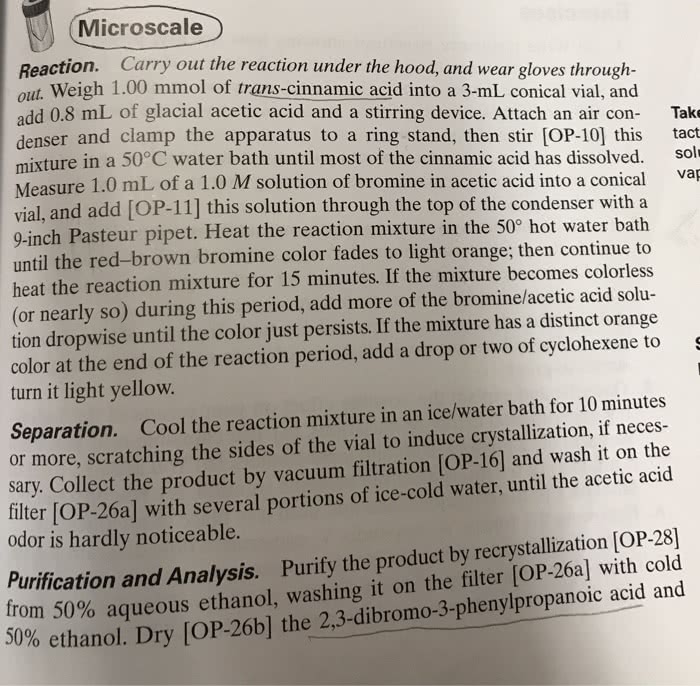table of reagents and properties:
Reagent MW (g/mol) mp(Celsius) d( g/ml)
trans-cinamic acid 148.2 132-135 acetic acid 60 1.05 pyridinium tribromide 319.8 - 2,3-dibromo-3-phenylpropanoic acid 308.0 Pair A: 93-95, Pair B: 202-204
Organic Chemistry- addition of bromine to an Alkene
For a lab the preparation of 2,3-dibromo-3 phenylpropanoic acid was done. 1.2 g of trans-cinnamic acid was dissolved in 4 ml of glacial acetic acid. 2.5 g of pyrimide tribromide was added to trans-cinnamic acid solution. Then a refulx appratus was assembled and the mixture was heated 1 hr. When the reflux was done, the mixture was cooled at room temperature and 15 ml of water was added to cool the solution on ice. The crude product was collected using a vacum filter and then transferred to a 25 ml Erlenmeyer flask. 3 ml of ethanol was heated and more ethanol was added to dissolve the collected product. Water was added on equal amounts of the total amount of ethanol used. The ethanol-water mixture was cooled at room temperature and then cooled on an ice water. The recrystallized product was collected through vacum filteration. The melting point was measured.
a. The melting point of the addition of bromine to trans cinnamic acid was a range of (189.2 C to 202.7C) so determine the sterochemistry of this addition of bromine to trans cininamic acid. what was the overall purpose of this experiment and what does the melting range indicate or can help conclude about the experiment? please be specific.
table of reagents and properties:
Reagent MW (g/mol) mp(Celsius) d( g/ml)
| trans-cinamic acid | 148.2 | 132-135 | ||
| acetic acid | 60 | 1.05 | ||
| pyridinium tribromide | 319.8 | - | ||
| 2,3-dibromo-3-phenylpropanoic acid | 308.0 | Pair A: 93-95, Pair B: 202-204 |
Organic Chemistry- addition of bromine to an Alkene
For a lab the preparation of 2,3-dibromo-3 phenylpropanoic acid was done. 1.2 g of trans-cinnamic acid was dissolved in 4 ml of glacial acetic acid. 2.5 g of pyrimide tribromide was added to trans-cinnamic acid solution. Then a refulx appratus was assembled and the mixture was heated 1 hr. When the reflux was done, the mixture was cooled at room temperature and 15 ml of water was added to cool the solution on ice. The crude product was collected using a vacum filter and then transferred to a 25 ml Erlenmeyer flask. 3 ml of ethanol was heated and more ethanol was added to dissolve the collected product. Water was added on equal amounts of the total amount of ethanol used. The ethanol-water mixture was cooled at room temperature and then cooled on an ice water. The recrystallized product was collected through vacum filteration. The melting point was measured.
a. The melting point of the addition of bromine to trans cinnamic acid was a range of (189.2 C to 202.7C) so determine the sterochemistry of this addition of bromine to trans cininamic acid. what was the overall purpose of this experiment and what does the melting range indicate or can help conclude about the experiment? please be specific.

